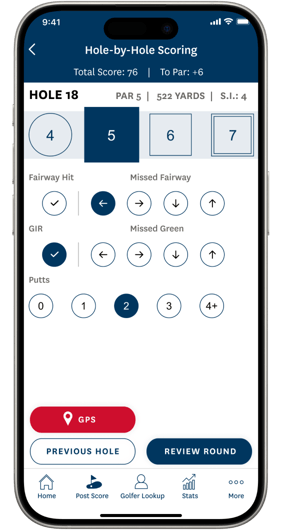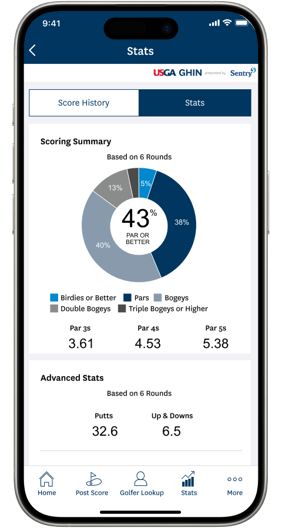

Golf Handicap Index® Explained
Handicap 101
For newcomers to the game, getting a Handicap Index and understanding it can be one of the great mysteries of golf. But it doesn’t need to be.
We offer valuable resources to guide you through understanding:- What it is
- How it’s calculated
- How to establish one
- How to make it work for you
A Handicap Index provides every golfer – regardless of age, gender or skill level – with a universal measure of playing ability under the World Handicap System™.

What is a Handicap Index?

Frequently Asked Questions
Expand All-
What is a Handicap Index?
Definition: A Handicap Index reflects your potential playing ability, calculated from the best 8 of your last 20 score differentials, adjusted for course rating, slope, and playing conditions. It levels the playing field between golfers of different skill levels.
Not all golfers are created equal, but with the golf handicap system, they can all compete with one another on an equal basis. For example, Tom’s average score is 80 and Meaghan’s average score is 95. With the handicap system, Tom ‘gives’ Meaghan a calculated number of strokes to level the playing field such that either of them has the same chance to win.
To put it simply, handicaps are equalizers.
Want a real (golf) world example? Read to learn what a golf handicap is!
-
How do I get a Handicap Index?
In the U.S., each state has one or more Allied Golf Associations (AGA’s) which are the authorized organizations for issuing and maintaining official WHS (World Handicap System) Handicaps. In Northern California, this is the NCGA.
Here are the basic 4 steps to get a Handicap Index:
Step 1: Join a Golf Club
To join the NCGA and get a Handicap Index, you must join a club. The fastest and easiest way to join is to Join NCGA direct via eClub.
Step 2: Get your GHIN Number
Once you join a club and get your GHIN number (Golf Handicap Information Network) which is a unique-to-you, numerical number that follows you around similar to a SSN to track your scoring history.
Step 3: Post a minimum of 54 holes
Using the GHIN app, you will then post a minimum of 54 holes (can be a mix of 18-hole scores and 9-hole scores) in the WHS system and your Handicap Index will be calculated.
Step 4: Wait... a day!
After you post the 54 holes, the system will automatically update on a daily basis with your calculated Handicap Index.
You will also receive Handicap Index Revisions via email on the 1st and 15th of every month.
Until your Handicap Index is calculated, you will see it listed as ‘NH’ which stands for No Handicap.
Want all the details on exactly how to get a golf handicap?
-
What does the Handicap Index Number Mean?
What does the handicap index number mean?
A Handicap Index is a numerical measure of a golfer’s potential ability and is expressed as a number with one decimal point (e.g. 21.4).
The World Handicap System (WHS) is the database application that you enter your golf scores into and that re-calculates your Handicap Index on a daily basis. When you join a NCGA member golf club, you will get a Handicap Index ID# (typically 6-8 digits). This is your unique system identifier for use when you enter or lookup scores.

The United States Golf Association (USGA) is the authoritative source of handicap index calculation methodology in the U.S. Effective January 1,2020, there is a new, unified World Handicap System with several new changes.
The USGA Handicap Index is calculated with a specific arithmetic formula that approximates how many strokes above or below the course rating a player might be able to play, based on the eight best scores of their last twenty rounds.
-
Why would I need a Handicap Index?
Why would I need or want a Handicap Index?
There are several good reasons to establish your handicap. A Handicap Index makes it possible for fair competition between players of different ability whether it’s in competitive events, a friendly wager between friends, or golf games with money on the line.
- If you get invited to play in a member-guest, company or charity golf tournament, they will want to know your handicap in order to put you in the right group and make the event fair for everyone. Don’t wait – get it now so you are ready when the invitation comes.
- Playing with friends or family usually involves a wager of some kind. By knowing what your actual handicap is, you can be confident that you are competing fairly and not losing wagers that you could be winning.
- Many golf groups or leagues or meet-ups have games with prizes; these too rely on players having up-to-date handicaps – get in on the fun of winning
- Not ready to play in golf tournaments or don’t want to play betting games or get prizes? Maybe you are just learning to play or practicing to get better. Keeping a handicap is a great way to track your improvement. As you improve, you can expect to see your handicap gradually go down.
- If you play on different courses, it is good to know what your handicap is so you can pick the right tees and gauge your relative success on one course vs. another.
- It is also a good reminder for beginners not to get frustrated. Say your handicap is 30 and you shoot a 105. Rather than feeling frustrated or unsuccessful, realize your score is only a few strokes over your net par, good job!
-
How is a Handicap Index calculated?
As a Handicap Index is intended to represent a golfer’s demonstrated ability, it is based on your better scores – the best 8 of your most recent 20.
Read more on USGA's Rules of Handicapping page: Rule 5 Handicap Index Calculation for detailed information on the rules and mathematics of handicapping.
Rule 5 covers the process of calculating a Handicap Index and incorporates the safeguards needed to help ensure that a player’s Handicap Index remains reflective of their ability and that equity is retained for all golfers. It includes mechanisms that:
- Take into consideration the conditions in which a round was played.
- Remember previously demonstrated ability within a defined period of time.
- Cap the upward movement of a player’s Handicap Index within a defined period of time.
- Apply additional adjustments to a player’s Handicap Index when an exceptional score is submitted.
-
How do I post a score? (using the USGA GHIN Mobile App)
Your NCGA membership includes a free golf handicap app called the GHIN Mobile App.
Download it for free from the Apple App Store or Google Play
Need step-by-step instructions on how to posting the GHIN app? Learn how to:- Log into the GHIN Mobile App
- Select the Course I Played
- The three methods to Post a Score
- How to enter my Round Data
- How to Edit My Score
- TL;DR Video (Too Long Didn't Read) Watch Video
Want to read the full article?
You can also post a score using these other methods
- Visit our website NCGA.org (you're here now!) there is blue button on the top right of the page to Post Score
- Post directly to USGA GHIN's online site GHIN.com
- Use the NCGA score posting computer kiosks in the golf course facility
-
What is Course Rating™ and Slope Rating™ on the scorecard?
When I look at a golf scorecard, they have #’s for Course Rating and Slope Rating, what do they mean?
These numbers are generated for each set of tees on each golf course to indicate the relative scoring difficulty (with normal weather conditions). The Course Rating is what a ‘scratch golfer’ (someone who typically scores par) is likely to score. Course raters also calculate a ‘Bogey Rating’. The slope, then, is a measurement of the difference between the Bogey Rating and Course Rating. Slope values typically range from 100 (easier) to 155 (extremely difficult).
Golfers use these as guides to select the set of tees to play from. Low handicap golfers look to the Course Rating, while beginning-to-intermediate golfers are more likely to look at the total yardage of the tees, as well as the Slope Rating, in order to gauge the relative difficulty.
NCGA Course Raters - our highly trained volunteers - rate each course roughly every six years unless substantial changes are made that would impact the course difficulty. This process and the know-how of the raters assures the integrity of the Handicap Index calculation.
-
Why are holes ranked 1-18 on a scorecard?
Also on the scorecard, why are holes ranked 1-18?
Called a ‘stroke index allocation’ this is a ranking of the holes based on difficulty, the 1st handicap hole is the hardest one to score par on and the 18th is the easiest.
-
What is a Course Handicap?
What is a Course Handicap and how is it different than my Handicap Index?
This is the number of strokes needed to play to the level of a par golfer on a particular course/set of tees. Unlike your personal Handicap Index, your Course Handicap is a whole number. It basically adjusts your personal Handicap Index to the course and tees you are playing.
The USGA GHIN mobile app has a course handicap calculator that will use the equation below – enter your Handicap Index and the Slope Rating of the tees you plan to play and it will give you the resultant Course Handicap.

Example: your Handicap Index is 16.4 and the Slope Rating of the course tees you are playing is 127, the calculator will tell you that your Course Handicap is 18. This means if the course is a par-71 course, add 71+18 = 89, then 89 is your par-equivalent score.

The USGA also has an online calculator that makes this calculation simple and fast!
Discover more about the calculation of a golf handicap in the article below.
-
What is a Net Score?
When you play a round of golf, the total number of strokes you take is your ‘gross score’. The ‘net score’ is determined by subtracting the Course Handicap from the gross score.
Following the above example: you play a round and your gross score is 89, subtract your course handicap 18, your net score is 71. That is a net par at Poppy Hills Golf Course!
-
What is Maximum Hole Score?
What is the maximum # of strokes I would post on a hole?
Ever had a bad hole, like getting a 10 on a par 4? For a player with an established Handicap Index, for score posting purposes only, the Maximum Hole Score will be a net double bogey. That is a gross double bogey, plus any handicap strokes (‘pops’) the golfer is entitled to on that hole based upon the ranking of the stroke holes.
For example, if you have a 25 handicap, the max hole score will be a gross quadruple bogey on the 7 hardest holes and a gross triple bogey for the remaining 11 holes. There is now a score posting feature for ‘hole-by-hole’ scoring in the GHIN app. If you use this, the system will do the calculations for you. (Prior to 2020, there was a similar concept called ESC which is no longer used.)
For a player submitting their first scores to obtain an initial Handicap Index, the maximum score for each hole played is limited to par + 5 strokes.
-
How to ‘give and get strokes’?
How do players with different handicaps ‘give and get strokes’?
This is the true beauty of the handicap system. If your buddy or competitor has a course handicap of 14, and you have a course handicap of 21, they have to ‘give’ you 7 strokes, sometimes called ‘pops’. If they beat you by 7 strokes, you tie; if they beat you by only 6 strokes, you win! This is the handicap at work!
The example below shows how strokes are applied in the GHIN App.
Bryan is a 2.9 handicap and Aimee is a 16.4 handicap. If they were to compete in match play at Poppy Hills Golf Course, they would need to apply the scoring differential for 18-holes as shown below.
Bryan would have to "give" Aimee 12 strokes since she is playing the Orange tees and Bryan the Black tees. This allows Aimee to compete fairly with Bryan during their friendly competitions.

Want to learn how to use the GHIN Mobile App's Handicap Calculator to Play with Friends? Check out the article below!
-
What does ‘popping the scorecard’ mean?
If you play in an event and give them your handicap, you may have seen little dots on the scorecard for each hole next to your name. This is for games when the net score for the hole is needed, or when you are playing match play or skins games.
The dots represent the number of strokes or pops that you are getting. If your handicap is 14, you get 14 pops, 1 for each of the 14 toughest holes. If your handicap is 21, you get 1 pop for all 18 holes, then your last 3 pops get added as one more each for the 3 hardest holes.

-
How do net tournaments and flights work?
How do Net Tournaments work and what do the flights mean?
Once you know the rules and have your handicap, you are ready to try out some ‘Net Tournaments’. All the scores are adjusted to net scores, so you are just trying to play as well as you can vs. your handicap level. In the example above, you have a 30 handicap and you score 105. If the course is a par-72 course, your net score is 105-30=75, not bad. That’s just 3 strokes over par and could get you prizes.
Flights are your friend! Flights are set up by handicap, so you will normally compete against players with a similar handicap. Since you are all on a similar footing, it can be an enjoyable experience. Many people meet new golf friends in this way.
Again, the magic of the handicap system. Golfers at every handicap level can enjoy playing in tournaments.
-
What is the maximum Handicap Index?
The maximum Handicap Index is 54.0 for all players.
-
What is Stableford in golf?
Stableford is a points-based scoring format where, instead of counting your total number of strokes, you earn points on each hole based on how well you play relative to par. Here’s the basic breakdown:
Double bogey or worse: 0 points
Bogey: 1 point
Par: 2 points
Birdie: 3 points
Eagle: 4 points
Albatross (you legend): 5 points
The beauty? You can pick up your ball after a blow-up hole because you’re not penalized with a giant number — you just get zero points and move on. That means faster play, less frustration, and more focus on bouncing back.Why Stableford Matters for Your Handicap Index
Stableford scoring is built into the World Handicap System.
- The World Handicap System (WHS) uses maximum hole scores (net double bogey) when you're posting your score hole-by-hole. That means really bad holes don’t drag down your Handicap Index too much.
- In effect, WHS already gives you a bit of that Stableford protection behind the scenes.
- If you don’t yet have a Handicap Index, joining NCGA gets you access to features (like GHIN app, score posting) that work with this system.
GHIN Mobile App Included Free




World Handicap System™
3 Key Changes for 2024
As announced by the USGA and R&A, several updates went into effect in January 2024. They feature three key changes:
- Incorporating shorter length courses into the course rating and slope rating system
- New treatment of 9-hole scores
- An updated approach for holes not played
Ready to Get A Handicap?
Questions about your Handicap Index?
Contact the NCGA at (831) 625-4653
Get the app:
GHIN Mobile
Post a score as you walk off the 18th green with the official app of the NCGA.












